World Telecommunication and Information Society Day (WTISD) 2025 – 160 Years of Iconic Phone Brands and Designs
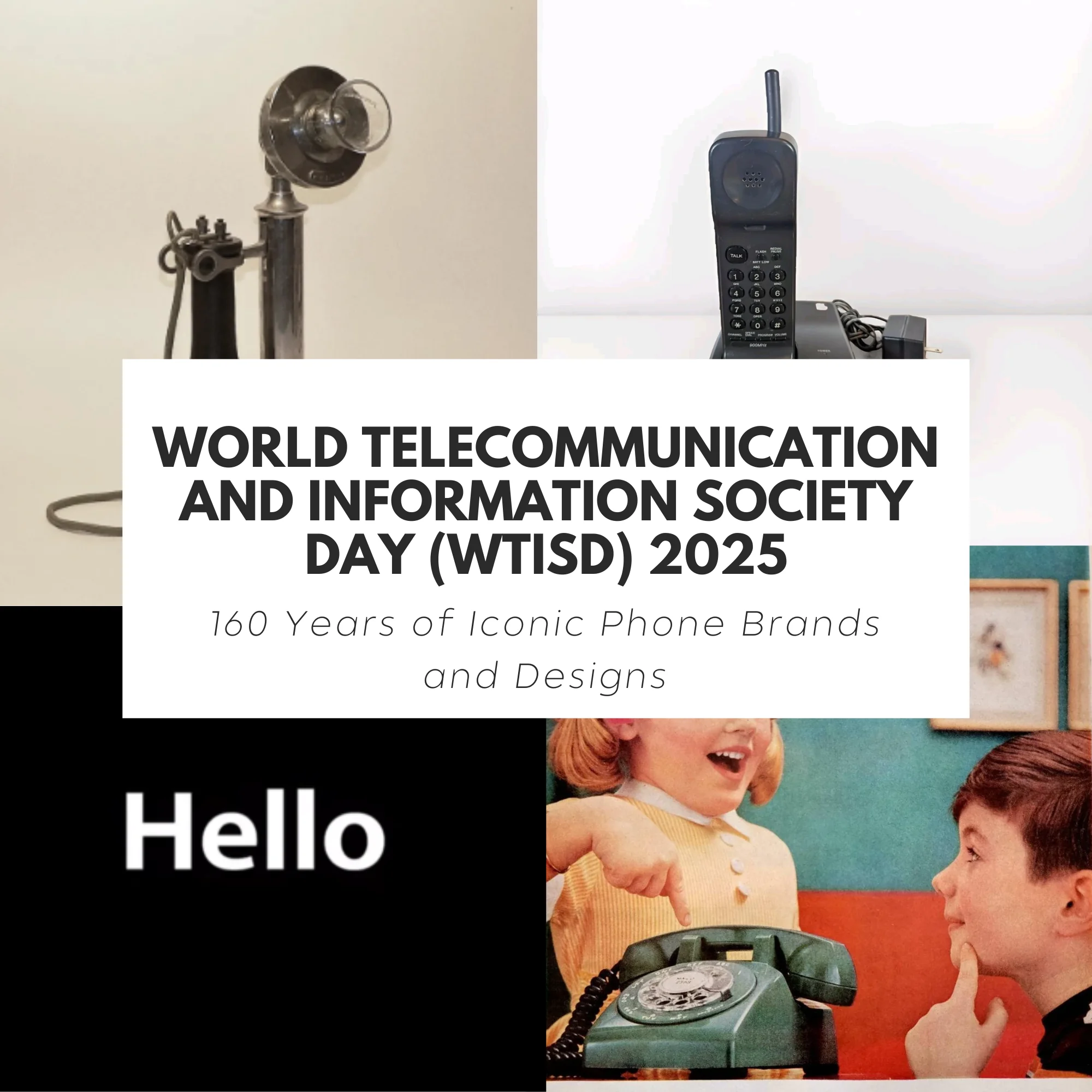
When I (Greg Vitarelli) was asked to write a blog acknowledging World Telecommunication and Information Society Day (WTISD) 2025, I refamiliarized myself with its origin, as a United Nations initiative, and its purpose to signify the founding of the International Telecommunication Union (ITU).
The ITU, which comprises 194 Member States and more than 1,000 companies, universities, and international and regional organizations, is charged with a critical mission to facilitate international connectivity in communication networks, which feeds the organization’s view that “Technology has become the backbone of modern life.”
Writing an article that succinctly captures such a wide remit of responsibilities was making my head spin. I needed something to focus on and be inspired by. Thankfully, I found it in an unusual place.
As most who have visited know, the borough of Manhattan consists mainly of a grid pattern defined by uptown, downtown, east side, and west side. It’s a simple design for such a complicated place. On the Upper East Side is the United Nations, from which the ITU is based. Close by – off 5th Avenue but within the boundaries of Central Park – is the Metropolitan Museum of Art, which recently held its Met Gala, to celebrate the opening of its Costume Institute’s annual fashion exhibit.
The fashions from the Met Gala are a delight to see, with many design innovations on display for the first time. Seeing this got me thinking about telephone designs, which is no less impressive than those at the Met Gala, but are arguably far more accessible to the rest of us than haute couture.
So, to celebrate this year’s WTISD, Escalate PR has hand-picked a ‘paparazzi-worthy’ runway of stars featuring some of telecom’s most iconic brands, designs, and moments from the past 160 years.
 First up is a logo that may surprise you because, believe it or not, it eventually went on to be one of the hottest brands in telecommunications. Look closely and you’ll notice that this is the original logo for Nokia, which, like the ITU, happens to be celebrating its 160th birthday this year.
First up is a logo that may surprise you because, believe it or not, it eventually went on to be one of the hottest brands in telecommunications. Look closely and you’ll notice that this is the original logo for Nokia, which, like the ITU, happens to be celebrating its 160th birthday this year.
The Finnish company, which dominated the cellular handset market from the mid-90s to mid-2000s, with Models like the 5190, 6190, and later the 1100, was actually founded on May 12, 1865, as a paper mill operator.
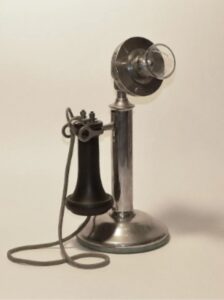 The importance of phone design and function was evident as far back as the early 1900s, as was the case with Western Electric’s 1020-B Nickel-Plated Desk Stand (circa 1904). This phone featured a hard rubber bi-polar “Pony” receiver with exposed terminals, and a “Whispering Mouthpiece,” which was specifically designed in glass to prevent the spread of disease.
The importance of phone design and function was evident as far back as the early 1900s, as was the case with Western Electric’s 1020-B Nickel-Plated Desk Stand (circa 1904). This phone featured a hard rubber bi-polar “Pony” receiver with exposed terminals, and a “Whispering Mouthpiece,” which was specifically designed in glass to prevent the spread of disease.
Even the language used to describe this phone was thoughtfully considered (from its product description): “The desk stands are carefully designed and constructed of the best materials obtainable. The working parts are held firmly within the upright tube or handle, and by taking out only one screw can be removed as a unit for the purpose of connecting or disconnecting the cords or for inspection.”
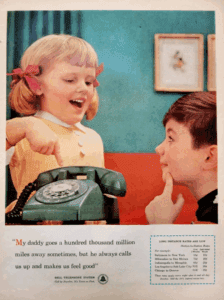 LIFE Magazine’s August 5, 1957 issue included this advertisement from Bell Telephone System featuring its Model 500 telephone. This was the standard domestic desk telephone distributed by Bell across North America from 1950 through to the 1984 Bell System divestiture.
LIFE Magazine’s August 5, 1957 issue included this advertisement from Bell Telephone System featuring its Model 500 telephone. This was the standard domestic desk telephone distributed by Bell across North America from 1950 through to the 1984 Bell System divestiture.
Its iconic shape was designed by the firm of industrial designer Henry Dreyfuss, a celebrated, Brooklyn, NY-based industrial designer whose impact on improving the look, feel, and usability of consumer products is still recognized today.
The Model 500 would be followed by Models 1500 and 2500, which offered a push pad for touch-tone dialing, which also came in exciting new colors like aqua blue!
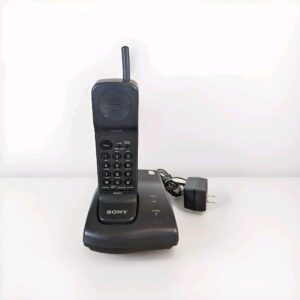 In the 1980s and 90s, the world went gaga about the Sony Walkman, which boasted an ability to “listen to music in a revolutionary way.” Clearly, it was felt that if our music could be set free to roam, so could our phone conversations. And thus a brand-new concept took hold – the cordless phone.
In the 1980s and 90s, the world went gaga about the Sony Walkman, which boasted an ability to “listen to music in a revolutionary way.” Clearly, it was felt that if our music could be set free to roam, so could our phone conversations. And thus a brand-new concept took hold – the cordless phone.
Arguably, the inspiration for the cell phones we enjoy today, models like this Sony SPP-85, relied on a base station that was connected to the public telephone network.
The handsets communicated within a limited range, via 900 MHz frequency radio waves, allowing users to “walk and talk” within a building or a short distance from the base station.
 ‘Hello,’ Apple’s first TV commercial for its first-ever iPhone aired on Sunday, February 25, 2007, during the Academy Awards. It was the perfect setting for the star-studded spot, which featured an array of real-life personalities, like Marlon Brando and Jerry Lewis, and fictional ones like Betty Rubble and Mr. Incredible.
‘Hello,’ Apple’s first TV commercial for its first-ever iPhone aired on Sunday, February 25, 2007, during the Academy Awards. It was the perfect setting for the star-studded spot, which featured an array of real-life personalities, like Marlon Brando and Jerry Lewis, and fictional ones like Betty Rubble and Mr. Incredible.
In this and subsequent high-profile moments, Apple transformed its iPhone, and arguably all smartphones, into the must-have devices that we use today.
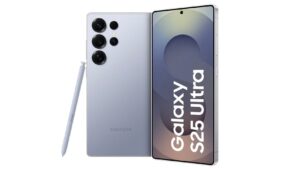 Last up on our runway of telephonic stars brings us to the current day, and a tidy bookend to our 160-year telecom journey.
Last up on our runway of telephonic stars brings us to the current day, and a tidy bookend to our 160-year telecom journey.
We are, of course, referring to the Samsung Galaxy S25 Ultra, which has been touted as one of 2025’s most exciting offerings.
While similar in functionality to its predecessor, this model’s updates are fashion-forward with design updates that include new rounded corners and a slimmer form factor.
The S25 is also bolstered by increased durability with a titanium frame, improvements to its screen cover glass, and a waterproof design that can be submerged in 5 five feet of water for up to 30 minutes. It’s easy to think this beautifully designed phone found a practical purpose as a camera, content creator, and publisher for those Met Gala stars!
From European and American designs to those from the Far East, the world of telecommunications truly embodies a common language of innovation. Alas, that’s all we have time for, but we hope we’ve sparked a memory and offered a reminder about the ubiquity, function, purpose, and beauty of our phones.
While these examples represent the public face of the industry, many other unsung innovations, which are strung along telephone poles and buried under our sidewalks, ensure we’re connected to one another.
Indeed, World Telecommunication and Information Society Day (WTISD) 2025 is something we can all celebrate – from engineers to marketers building bold new telecom public relations strategies that connect people to progress!
